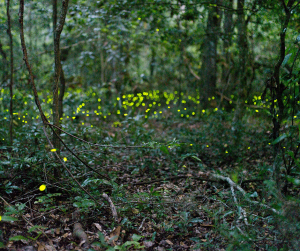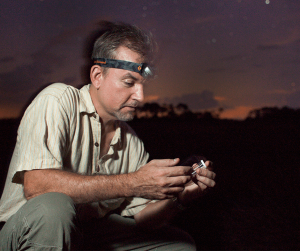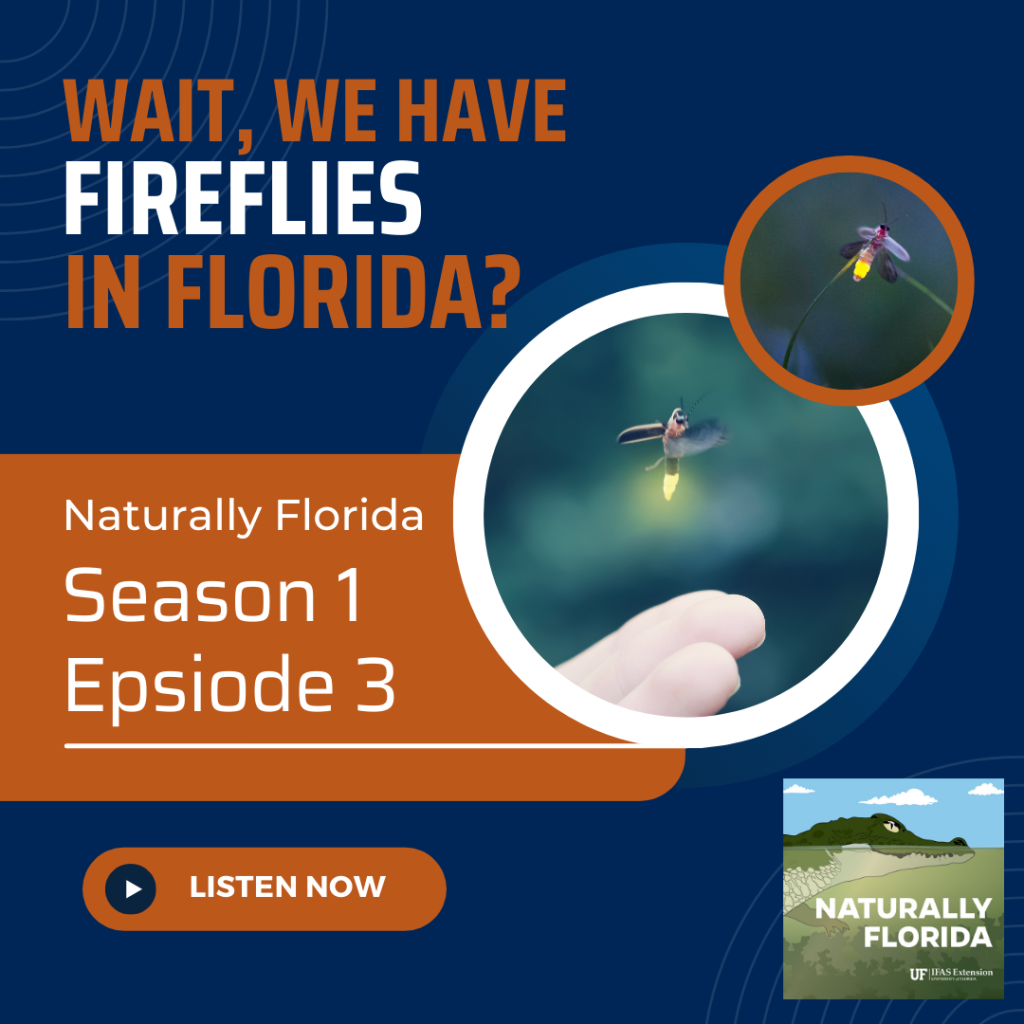As the Florida sun sets low in the sky, it is time for one of Florida’s spectacular wonders. The nightly firefly show. In dark areas near waterways with tall grasses, shrubs, or trees, you can catch a glimpse of the elusive Florida fireflies (also known as lightning bugs). Dancing through the air, occasionally flashing their delicate lights, they communicate with each other about their location, to warn off predators, and to mate with other fireflies.
With increasing urbanization, there are fewer and fewer locations to view nature’s bioluminescent show. Firefly sightings have become so scarce that some Florida residents have never seen a firefly. However, some places in Florida remain untouched and far away from ambient lights, pesticides, and urban development.
Where to Look
Florida State Parks remain a haven for these wondrous creatures. Parks that offer camping or have firefly tours open to the public after sunset are a great place to look for fireflies in late spring and throughout summer.
Blue Spring State Park and Friends of Highlands Hammock State Park offer firefly tours annually, usually around March or April. Blue Spring’s firefly event is open for two weeks, varying in March and April, depending on the first firefly sightings of the season. This year the tour was a one-hour self-guided tour. In addition, guests could walk down the firefly trail to witness nature’s light show. In the past, the Highland Hammock tours were offered as tram tours for a small entry fee, park admission was waived if you entered at sunset as a registered tram tour guest.

Every state park is different, and in each area, visitors can witness different fireflies. In Florida alone, there are 56 species of fireflies. Some can fly, others burrow into the ground, some can flash their light, and others are a constant glow. Some flash bright yellow and others green, and some age out of the ability to flash and glow. The key is finding a dark place with lots of natural cover such as a forest edge, tall grass, or shrubs, and if there is a water source like a stream or pond.
A previous version of this post recommended a trip to Lake Kissimmee State Park for fireflies. We have since removed that suggestion as LKSP does not have a noticeable firefly season. If you go camping there in the summer, you may see some lightning bugs as they have several areas of suitable habitat; however, it is not a known hotspot at this time nor has it been any in recent memory.
When to Look
Fireflies are in the taxonomic group Coleoptera (beetles), which means they are not actually flies. Each beetle, like humans, prefers a different habitat. If the firefly prefers purely aquatic food, then a lake, pond, stream, swamp, or marsh will house their food and young. Some prefer spaces with tall grasses or wooded areas with native plants to feed on.

The timing of the sightings is also a factor to consider when planning to see fireflies. The Florida firefly season starts in early spring through late summer. During the firefly season, some species can flash or glow all night. While others, according to Marc Branham, an Associate Professor of Entomology at the University of Florida, make an appearance for 23 minutes at a time. Knowing the species of firefly is another factor in the hunt for a firefly sighting.
The Florida Sprite, for instance, makes its appearance at sunset, lasting on average 30 minutes before vanishing again. According to Lynn Faust, author of Fireflies, Glow-worms, and Lightning Bugs, the Florida Sprite is most abundant in “April through May and again in July through August” (2017). In addition, the Florida Fishhook is most abundant during late spring (April – May) and late summer (August). These little guys can be seen eleven to twenty minutes after sunset.
The Lifecycle
Spotting fireflies can be difficult. The reason for this difficulty is the firefly lifecycle. Fireflies emerge into the adult stage for only 3-4 weeks before perishing. The firefly lifecycle has four stages called the egg, larvae, pupa, and adult stages. A firefly will remain an egg for three weeks or less, then emerge as larvae. In this stage, the firefly is a fearsome glowing predator: hunting snails, slugs, and other insect larvae. They also use a defensive numbing agent called lucibufagin.
The larvae stage lasts from one year to two, making their habitat conservation vital. Next, the firefly larvae grow into a pupa. The pupa stage is about transformation, of going from a larva into an adult firefly. A firefly can emerge from the pupa stage at the end of February through the end of summer in July into an adult firefly.
Firefly Identification
In the adult stage, a firefly can have a wide range of looks. For instance, according to Faust (2017), the Railroad-worm females are glowing worms. While the males are smaller in size, emit a faint glow, have feathery antennas, and fly, unlike the females. While the most common species in the Eastern United States is the Big Dipper J-Stroke ss has similar-looking males and females. Both genders of Big Dippers, on average, range from 10-14 mm in length, have a pink/red dot on their head shield with a black/brown dot in the center and two long antennas. For easy identification, the Big Dipper’s wing covers look similar to sunflower seed in coloring with a slimmer shape.
Another species found in Florida is the Florida Fishhook (Photinus collustrans). These little guys range from 5 to 11 mm and have similar shape and color markings to the Big Dipper. However, like the Railroad-worm, the Florida Fishhook females are flightless, wormlike, and pink and yellow in color. They are found all throughout Florida in grassy areas, sandy soil, and areas with scattered trees. Overall, Florida fireflies come in a wide range of appearances and flash patterns, with 56 species in the state alone, there is a healthy variety for Floridians to find.
Want to learn more about Fireflies in Florida? Check out our other blog post, “How to Create a Firefly Oasis.“
Check out our Naturally Florida podcast episode, “Wait, We Have Fireflies in Florida?”

Sources
- Explore Research at the University of Florida. (November 27, 2013). Nature Night Lights. Entomologist Mare Branham is building UF’s reputation as a firefly research hotspot. http://explore.research.ufl.edu/night-lights.html
- Faust, L. (2017). Fireflies, Glow-worms, and Lightning Bugs. University of Georgia Press. 39-168
- Firefly Conservation Research. (2021). Disappearing Fireflies. https://www.firefly.org/why-arefireflies-disappearing.html
- Llyod, J., Addison, M., Trotter, J. (1996). Introducing Fireflies. Flyer Companion and Letter. 1, 2, 1-9. http://entnemdept.ufl.edu/lloyd/firefly/ffcomp1-2.pdf
- The National Wildlife Federation. (n.d.). Fireflies. https://www.nwf.org/Educational-Resources/Wildlife-Guide/Invertebrates/Fireflies
- UF IFAS Gardening Solutions. (May 15, 2015). Fireflies. https://gardeningsolutions.ifas.ufl.edu/design/gardening-with-wildlife/fireflies.html
Originally Published: June 5, 2021
This blog post was written by Natural Resources Extension Program Intern, Ms. Kaitlyn Harwell, under the supervision of Natural Resources and Conservation Extension Agent, Mrs. Shannon Carnevale.
University of Florida IFAS Extension is committed to diversity of people, thought and opinion, to inclusiveness and to equal opportunity.
UF/IFAS Extension is an Equal Opportunity Institution.
 0
0
